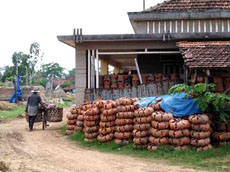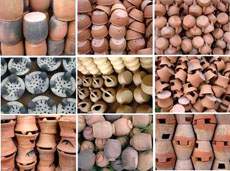A rival is creeping up on the country’s better known pottery villages, as this skilful southern village makes a name for itself.

Quietly developing alongside Vietnam’s other well-known pottery villages, such as Bat Trang and Phu Lang in the north and Bien Hoa and Lai Thieu in the south, Van Son village in southern Binh Dinh Province has unique characteristics, which have earned it a following among many pottery buffs.
Skilful village craftsmen make pottery of all shapes and sizes, from enormous jars and flower pots to small necklaces and children’s toys. Van Son pottery is fired at extremely high temperatures to produce the trademark reddish-brown colour preferred by customers.
The secrets of the Van Son ceramics trade have been handed down through many generations. "As long as people continue taking Chinese traditional medicine, planting orchids in traditional ceramic bowls and eating rice cooked in earthenware pots, the traditional work still exists," said Phan Thi Nhai, a craftsman in the village.
In additional to traditional markets such as Da Nang City and Thua Thien-Hue Province, Van Son pottery products have earned a firm foothold in other provinces, such as Kien Giang, Rach Gia and Quang Ninh.
In order to produce high-quality products, every step must be carefully followed: choosing and preparing clay, making glazes, shaping and smoothing the product and finally firing, according to Le Van Hung, head of a pottery production plant in Van Son village.
"Clay affects all these stages and the pottery item’s value. There are many kinds of clay, such as reddish-brown clay and white clay and each kind of clay can be used to make a certain product," he said.
Artisans must first choose clay which is malleable enough to ensure the sustainable quality of the product. After the clay is collected, it will be dried out, smashed into pieces and covered with a plastic bag to preserve it.
Making trademark glazes is an important step in the creation of Van Son pottery, he said. Dull and transparent glazes are the two types of glaze used in ancient Vietnamese pottery. However, in order to draw more customers, local craftsmen have created glazes of different colours and characteristics by combining the two main glazes with natural materials like silt, tree ash, straw and stones.
"Depending on the purpose, pottery can be glazed once, twice and sometimes more, either before or after it is fired. It can also be painted underneath or on top of the glazed coat, or even between coats. In some cases, a glazed product, like crackle-glazed items, may require the potter to control the temperature it is fired at using his knowledge of the type of clay," he said.
Shaping the product is not physically demanding work, but requires careful craftsmanship; it is not simply throwing some clay on a wheel and shaping it with your hands.
Products must be left to dry and are then smoothed, carved and carefully checked before they are fired. This important job requires highly skilled potters since it will determine the product’s value.
The last step – firing – is hard and complicated work. "A small mistake will lead to considerable damage so firing is the challenge, and also the pride, of potters," Hung said.

There are many types of kilns used for firing different kinds of pottery, such as a cylinder kiln and a square kiln. First, artisans put unfired products and timber or charcoal into the kiln in a particular order, to ensure that all clay is fired at a suitable temperature. The chief potter then watches the colour of the fire inside the kiln to determine when the pottery is finished.
Van Son pottery is popular among customers due to its quality and unique colour. "In order to get the reddish-brown colour, a unique characteristic of Van Son pottery, local craftsman use ‘chanh ranh’ leaves – a special kind of tree which grows in Van Son – to fire the products.
The clay of Van Son village is good, but without the fire burned from ‘chanh ranh’ leaves, the products would look the same as others in the marketplace," Hung said. In order to further develop and promote the traditional craft, local authorities have opened training classes for young labourers and are actively seeking new markets, according to To Hong Phuong, chief of Van Nhon District’s People’s Committee Secretariat.
"The majority of products have been sold in the domestic market, including Kien Giang, Rach Gia and Quang Ninh, but have not yet found a foothold in foreign markets, which requires increased efforts from local authorities, craftsmen and businesses to diversify and improve product quality," he said.